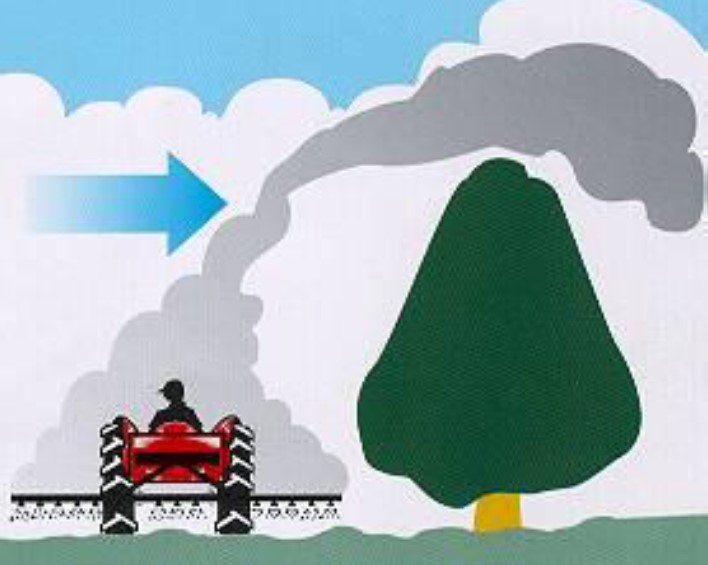Reducing spray drift using buffer zones and vegetative barriers
This page outlines the potential value of buffer zones and vegetative barriers when applying pesticides to cropping and horticultural crops.
Often these are seen only of value to protect from herbicide spray drift between broadacre cropping and horticulture. However, the risk is equally important with fungicide and insecticide use in horticulture causing contamination of broadacre crops as well as other types of horticultural crops.
What is a buffer zone?
An area left designated as a no spray zone between a sensitive area and a crop being sprayed is known as a buffer zone. A buffer zone often forms a strip of unsprayed paddock, but may also contain a vegetative barrier within it. The presence of a buffer zone allows spray drift to settle out of the air stream as it travels across the buffer zone before reaching the sensitive area.
The required distance of a buffer zone will vary a great deal and may be different from day to day as you must take into account:
- the product you are using. Some require buffer to be used in order to legally use the product. When using products that specify a required buffer distance it is important to make a note that this was observed when making a record of use.
- the type of application equipment, as a boom sprayer applying a COARSE droplet size is less prone to drift than a mister applying a FINE droplet size
- the nature of the sensitive area you are trying to protect, as different distances may be required for crops compared to residential housing or other contexts
- the environmental conditions on the day, especially the wind direction and speed.
What is a vegetative barrier?
A row of trees, or shrubs or tall grasses can be planted in strategic lines to reduce the extent of spray drift of agricultural chemicals. They can achieve this by filtering out spray droplets in air passing through their foliage.
Limitations of buffer zones and vegetative barriers
It is important to be aware of the following limitations:
- Buffer zones and vegetative barriers are not a substitute for good agricultural practice (GAP). If it is too windy, you should not be spraying as either a buffer zone or a vegetative barrier may not be able to stop drift. They are intended to reduce the risk when spraying in nearly ideal conditions and help protect against unpredictable gusts.
- Buffer zones and vegetative barriers will not stop vapour drift or odour occurring, this is purely a consequence of the product itself and the weather conditions.
Why plant a vegetative barrier?
A good vegetative barrier works by allowing air to pass through foliage while filtering out spray particles and reducing possible damage to human health, the environment, crops and livestock.
Other benefits of vegetative barriers include productivity gains from improved crop and livestock shelter, filtered noise and dust levels, reduced complaints from concerned neighbours, lowered water tables, habitat for wildlife and increased aesthetic values.
Effective Vegetative Barriers
A good vegetative barrier should be:
- semi-permeable - you should just be able to see through it. This allows air to pass through foliage, filtering out spray particles and dust.
- at least 50% taller than the target plant.
- located in consideration of sunlight and prevailing wind direction.
- multi-rowed if possible.
- made up of species with long, thin, rough foliage, e.g. Casuarina.

What to plant
Some examples are:
Trees:
- casuarina and she-oaks are ideal species.
Shrubs:
- tea-tree, e.g., Leptospermum, Melaleuca
- banksia.
Tall grasses:
- grass buffer belts are useful for low growing crops only
- rye corn
- sorghum.
Where to plant
Examples of suitable locations for planting vegetative barriers:
- on crop boundaries
- next to sensitive areas
- between blocks or paddocks
- along sprinkler rows (low growing crops only).
More resources
- Buffer zones and vegetative barriers — Buffer zones and vegetative barriers are valuable tools that can be used to reduce the potential for spray drift when applying agricultural chemicals.
- Living in harmony pesticides and bees — Information on managing risks associated with agricultural spraying near apiary sites.
- Recognising surface temperature inversions — It is unsafe to spray when conditions favour surface temperature inversions, due to the potential for spray drift. Learn how to identify weather conditions associated with surface temperature inversions.
- Spray drift restraints and mandatory buffer zones — This page explains some of the operating principles in relation to spray drift risk such as how to correctly apply mandatory buffer zone labels.
- Visual Guide to estimating wind speed — This guide is not intended as a substitute for electronic hand held weather meters, which are available from spray equipment suppliers.
- Volatile vapour drift risk — Learn about the risks associated with volatile vapour production by ester formulations of phenoxy herbicides.